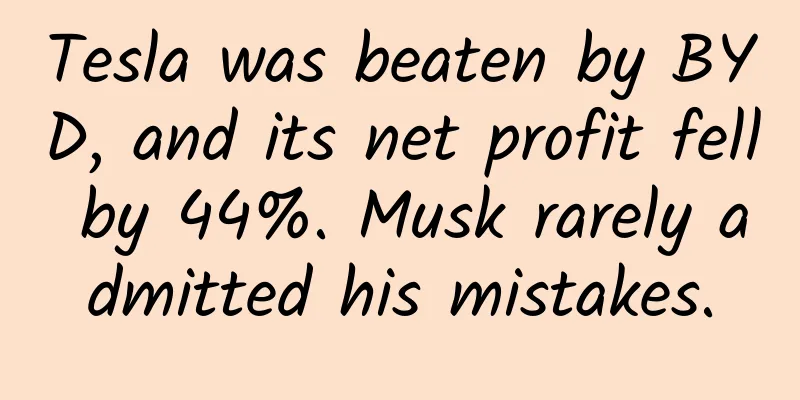Can't stand it anymore! The alliance of frustrated car industry members condemns the price war. Is it a wise opinion or is it that the weak are right?

|
The Chinese auto industry is arguing again! In the past, the arguments were about technology, service or certain concepts; but the recent wave of bickering is different from the past, because many manufacturers are facing life and death, and their mentality has completely collapsed. This wave of debate probably started with Richard Yu. At the 2024 Second Future Automotive Pioneer Conference on June 1, Richard Yu put forward a viewpoint: BYD should be the current leader in the new energy vehicle industry because of its ultra-low costs. In fact, the entire industry knows about this. At the fifth-generation DM technology launch conference on the evening of May 28, BYD directly lowered the starting price of the two B-class cars, Qin L/Seal 06 DM-i, to less than 100,000 yuan, which not only shocked its competitors, but also BYD's own A-class cars such as the Destroyer 05 and Qin PLUS. If it was just a statement of fact, then Yu Chengdong's words might not be controversial. But Yu Chengdong then claimed that Huawei is not good at ultra-low prices, but is good at value, intelligence, luxury, comfort and safety performance. This comparison quickly attracted the attention of the industry. Yu Chengdong intentionally or unintentionally labeled BYD as low-end, which resonated with many manufacturers, many of which had been forced into a corner by the price war launched by BYD. At the beginning of the year, when BYD's Honor version lowered the price of A-class plug-in hybrid vehicles to 79,800 yuan, some manufacturers were still able to follow suit; but when Qin L was launched, other manufacturers had chosen "not to follow" because they really couldn't sell it anymore. It is important to note that the price war in China's new energy vehicle market has been going on for several years, and it is not all about BYD. At the beginning, the "king of the market" was Tesla, and there have been many discussions in the market that "Tesla's price cuts will kill domestic cars." During a certain period of time, whichever manufacturer occupies a dominant position will take the initiative to initiate a price war to compete for more market share. This is the general law of industry development and cannot be changed even if any manufacturer opposes it. It can be said that price wars and internal competition are inevitable in the development of China's new energy vehicles. Compared with traditional fuel vehicles, new energy vehicles are absolutely new things. In the early stages of development, they have the problem of inflated prices. If China's new energy vehicles have been developed for so many years and the prices are still high, it would be a failure. Therefore, there is no clear boundary between price and value. In other words, manufacturers who cannot create value will not dare to easily join the price war. The normal development logic of the new energy vehicle industry should be this: technological progress brings about value enhancement, which then brings about an expansion in sales volume. After the sales volume expands, production costs, procurement costs, and publicity costs will all drop significantly, and profit margins will also increase significantly. Then the next wave of price reduction will begin. After a few years, the prices of mainstream models will drop to a reasonable range. This is the basic logic behind the frequent price wars in China's new energy market. It is a positive energy, not what Geely Chairman Li Shufu said: "Price wars lead to cutting corners." The current prices of new energy vehicles are unstable because China's new energy market is developing too fast and the price system is being restructured. When the market matures, consumers only need to listen to the positioning of a car to know how much it will sell for. In fact, the fuel vehicle market was like this at the beginning. More than a decade ago, the prices of many joint venture models were ridiculously high, but after so many years of fierce competition, the prices of mainstream brands are declining. The average price of Toyota, Volkswagen, Honda and other manufacturers is actually around 150,000 yuan, and the sales of the entire automobile market have also ushered in a big explosion. Everyone understands this principle. But some manufacturers followed Yu Chengdong's lead, which is a typical example of "I am weak, so I am right". Huawei holds the trump card of intelligent driving and has the capital to challenge BYD. What are the reasons for others to follow suit? Not all manufacturers can keep reducing prices for a long time. Some manufacturers’ products are not well received, sales cannot be increased, and costs cannot be diluted, so they are afraid of price wars. In the car industry, being unskilled is the original sin. As BYD's PR General Manager Li Yunfei said, if you can't keep up, you can just move on to the next model. There's no need to turn the table. Now, too many manufacturers are starting to turn the table. Those traditional joint ventures that can’t sell many new energy vehicles a year, traditional domestic manufacturers that rely on joint ventures to survive, and new car-making forces that have no technology and can only hype concepts. To exaggerate a little, regardless of whether BYD is the one who initiated the price war, these “backward forces” will be eliminated. In order to gain a foothold in the current highly competitive market environment, major manufacturers can only continuously increase their R&D investment and use product performance to promote sales growth, and then they can gain a firm foothold in the mainstream market. The Chinese new energy vehicle industry is what it is today mainly because the leading manufacturers have mastered the core technology. Whether you are competing on price or value, core technology is indispensable. When Geely, Chery and other domestic brands were just starting out more than 20 years ago, they were only able to compete on price. Therefore, they did not have industry dominance throughout the era of fuel vehicles. In the new energy era, China's mainstream manufacturers can not only compete on price, but also compete on value and service. Therefore, they can occupy more than 60% of the global market share. In April, the penetration rate of new energy vehicles in China reached 50%, and they have been recognized by a large number of consumers. What can a few slow-transforming manufacturers who have formed a "frustrated alliance" and complained about something that consumers have recognized? As a winner of Toutiao's Qingyun Plan and Baijiahao's Bai+ Plan, the 2019 Baidu Digital Author of the Year, the Baijiahao's Most Popular Author in the Technology Field, the 2019 Sogou Technology and Culture Author, and the 2021 Baijiahao Quarterly Influential Creator, he has won many awards, including the 2013 Sohu Best Industry Media Person, the 2015 China New Media Entrepreneurship Competition Beijing Third Place, the 2015 Guangmang Experience Award, the 2015 China New Media Entrepreneurship Competition Finals Third Place, and the 2018 Baidu Dynamic Annual Powerful Celebrity. |
<<: Samsung Galaxy S6 battery leak: capacity decreases instead of increases
>>: Deloitte Consulting: 2024 US Generative Artificial Intelligence Report
Recommend
User Operation: AARRR Model for Products from Zero to 200,000 Users
Without further ado, the full article is structur...
How to use the mini program for physical stores in Lanzhou? How to create a physical store mini program?
Many people think that the store app is not diffi...
Is IP marketing a powerful tool for brands to break through?
The summer of 2017 may become a turning point in ...
Giraffe genes were transferred into mice, but the mice did not grow long necks, but...
Produced by: Science Popularization China Produce...
Weibo KOL placement guide (Part 1)
I know that 50% of my advertising dollars are was...
Is the “Sky Eye” useless? Chief scientist: Basic research has never been driven by “use”
On the afternoon of July 9, Li Di, chief scientis...
Facebook is losing its appeal? Maybe it can learn two things from Ingress
According to the latest survey by Piper Jaffray, ...
My face turns red and my heart beats fast when I see someone I like. What's wrong with me?
Adolescents are facing tremendous changes both ph...
A complete guide to Douyin dou+ placement skills
With the explosive growth of Tik Tok, the gamepla...
Banners, patches, information streams... Among so many advertising formats, which one is more efficient?
In recent years, programmatic advertising has bec...
Even if Apple comes, it won’t work. Why is the experience of in-car operating systems far inferior to that of mobile phones?
We are in contact with operating systems all the ...
Case Study: 12 Gamification Strategies for User Growth
This article uses a case study to introduce how t...
Charging and battery swapping modes: who is reliable and who is cheating?
Even though it has suffered the double blow of th...
Introduction to Apple and Android download reviews and quotations!
Qinggua Media Android front-end display optimizat...
Xiaopeng Motors G3 will be launched this spring, and the OEM is finally not JAC
Nowadays, the decline of subsidies for new energy...









